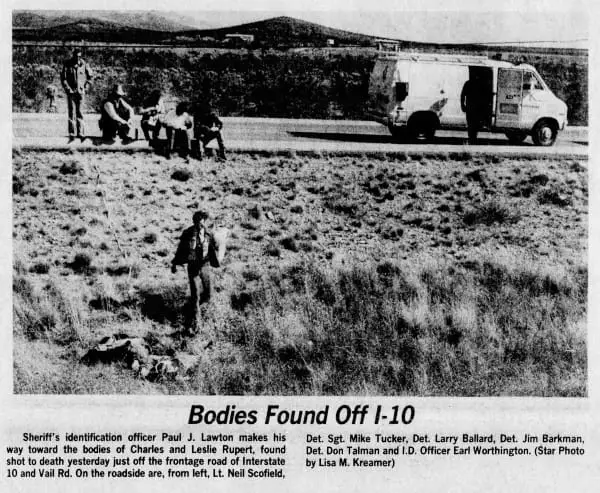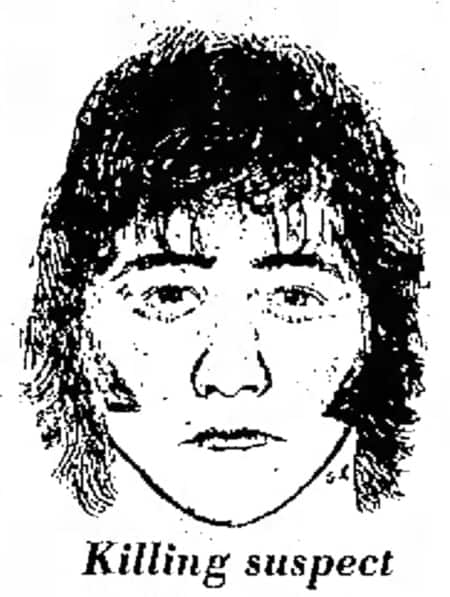Charles and Leslie Rupert were married on May 28, 1974. Both were graduates of the University of Arizona (UA) in Tucson, Arizona. Charles was originally from West Virginia, and Leslie was from Phoenix. She was a graduate student in the Department of Public Administration, and Charles held a master’s degree in corrections from the same department.
Charles Rupert was the son of Rodney C. Rupert and Helen Goff. He has a sister Jo Ann, and two brothers, John Rupert and O. Homer Lambert.
Leslie Rupert was the daughter of Arnott Duncan, a former Arizona Republic sports editor who passed away from cancer in 1962, and Mrs. Carl E. Weiler of Phoenix. She has three sisters, Cynthia, Lyle Duncan, Vicki Weiler, and three brothers, Michael, Arnott III, and Patrick Duncan.
Charles and Leslie Rupert resided at 508 W. Roger Road in Tucson, a halfway house they started for ex-convicts.
The Rupert’s volunteered their time at Seventh Step Foundation, an organization geared toward helping parolees recently released from prison. The organization was nationwide and similar to Alcoholics Anonymous. The Phoenix chapter started sometime around 1965.
The Murder of Charles & Leslie Rupert
On the night of Saturday, February 1, 1975, Charles, 27, and Leslie, 22, attended a banquet at Seventh Step Foundation in Fort Grant, AZ, about a 2-hour drive northeast of Tucson, near Stafford.
Charles’ mother, Helen Goff, loaned the couple her 1970 Ford Mustang after Charles drove her to the airport, where she departed for Los Angeles for the weekend.
Around 10:45 p.m., Thomas Weldon, area director for Seventh Step, attended the banquet, and his family was getting ready to leave when he saw Leslie Rupert putting her coat on.
Weldon said about 150 to 200 attendees to the banquet, but none of them had served time in prison. He said in 1975, “Three or four ex-convicts were there along with everyone else, but they left with people they came with.”
Charles Rupert was supposed to pick up his mother, Helen, at the airport at 4:00 p.m. on February 2nd, but he never showed.
At 10:15 a.m. on Sunday, February 3rd, a passing motorist found the bodies of Charles and Leslie Rupert in a drainage ditch south of Tucson off Interstate 10 near the Vail Road off-ramp. Both had been shot and were lying next to each other. Police found money on the victims ruling out robbery as a motive.
Police found two speeding tickets on Charles’ body – one issued at 11:00 a.m. and the other at 6:05 p.m. on February 1st. Tom Weldon told police the couple was late to the banquet because Charles got a speeding ticket.

Later that day, at 3:30 p.m., Highway Patrol officers found the Ruperts car on Interstate 10, near Casa Grande, between Phoenix and Tucson. The vehicle was near a gas station. The back seat contained a “considerable amount of blood,” but police did not find a blood trail leading from the car to the bodies.
Autopsies revealed that Charles was shot once in the side of the head and twice in the back with a .38-caliber revolver. Leslie was shot once behind the ear and had not been sexually assaulted.
Authorities estimated the couple had been killed sometime between midnight and 2:00 a.m.
Investigation
Deputies had the car towed back to Tucson and dusted for fingerprints, but someone wiped the car clean. There appeared to be writing on the inside of the rear window; however, the only letter police could make out was “P.”
Carl Sutton, manager of the Freeway Shell Station, told the Casa Grande Dispatch in February 1975 that he had noticed the abandoned car shortly before noon on February 2nd from his home behind the station and figured it ran out of gas. A highway patrolman later called him, asking Carl to tow the car to the Pima County Sheriff’s Office. Carl also said to his knowledge, none of his employees saw the driver. Carl himself didn’t see the driver either because he did not open the station that morning.
Stanley Harwood, secretary for Seventh Step, said sometime in the previous 90 days, someone broke into the Ruperts home and stole about $1,200 worth of stereo equipment.
Possible Link
On the night of February 4, 1975, a Westland, Michigan man named Ronald R. Fawley, 26, picked up three black males on U.S. 60 east of Phoenix.
Fawley was on his way home to Michigan. The men forced him into his trunk in Tulsa, Oklahoma. The hitchhikers then drove to Swope Park in Kansas City, Missouri. They let Fawley go and told him to run. The men shot him in the spine and right thigh as he ran away.
Fawley was taken to a Kansas City hospital and listed in critical condition.
The men got away, and police never recovered Fawley’s car.
Kansas City Police Captain Robert Jenkins noticed the similarities between Fawley’s shooting and the killing of Charles and Leslie Rupert.
Authorities wanted to compare the slugs in Fawley’s shooting with the bullets recovered from the Ruperts’ bodies.
While this author could not find further information about the outcome of this possible link, it’s reasonable to assume it led nowhere because the Rupert murders are still unsolved.
Witness Comes Forward
About three weeks after the murders, a witness came forward saying he saw a man driving the Ruperts’ car the night of the killings. Pima County Sheriff’s Office produced a composite sketch based on the witness’ account.

The witness, a gas station attendant, said the man pulled into the gas station, located near Interstate 10 on Sunland Gin Road in Casa Grande, AZ, between 1:30 and 5:00 a.m. on February 2nd. The suspect exited the car and went inside to use the restroom, but the attendant didn’t see him get back into the vehicle.
The attendant described the suspect as white, 25-30 years old, between 5’10” and 6′ tall, with a stocky build. The man had dark blonde neck-length hair and a pockmarked face.
The suspect’s appearance was “weird” and “grubby,” wearing old, well-worn clothes and greasy blue jeans.
Despite the circulation of the sketch, police never identified the suspect.
Theories
There are a few theories about Charles and Leslie Rupert’s murder.
Hitchhikers Killed the Couple
Tom Weldon told police he had seen two hitchhikers on I-10 near the sierra Vista cut-off on the banquet night.
“They were walking on the road toward Tucson at a little before midnight. And they were scroungy. They waved and yelled. One of them was a big man, and the other was around 5’8″. One of them had long hair, and the other had a beard. The one with the beard turned around and waved,” Tom said in 1975.
Tom told this to the police because he thought Charles might have picked them up. After all, Charles had picked up hitchhikers in the past.
Deputies later said they believed a hitchhiker killed the couple.
Regardless, the descriptions of the hitchhikers that Tom Weldon gave police did not match the person in the sketch.
Contract Hit on Charles Rupert
Charles Rupert’s mother ultimately discounted the hitchhiker theory. For one, she thought a hitchhiker would have robbed the couple or sexually assaulted Leslie, or both. That left revenge or insanity as the motive, according to Helen Goff in 1978.
She went with the revenge theory, and here’s why.
After Charles earned his master’s degree, he applied to the UA’s law college. Still, he was refused admission because of an “unsatisfactory undergraduate grade average at Morris Harvey College in Charleston, West Virginia,” according to the March 27, 1978, Arizona Daily Star.
Charles sued the department. He contended that the UA discriminated against him because he was white. Minority-group applicants with lower scores had been admitted (Medlyn A4).
Charles also said the UA’s admission process was unfair because the school did not consider the grades he received in the school’s graduate program. If the UA had, he would have been admitted.
Once Charles filed the suit, UA officials claimed they took a look at his transcript again and found that his grade point average was lower than they initially thought. Charles called their claim an “unlikely coincidence.”
Charles acted as his own attorney and was admitted to law school pending an Arizona Court of Appeals decision. The lawsuit became moot with his death (Medlyn).
Charles’ mother, Helen Goff, told the Arizona Daily Star in 1978, “Due to racial tensions, I feel that that suit could conceivably be the cause of his death. A lot of people stand to lose in a reverse-discrimination suit.”
Charles Rupert Was An Informant
This theory was based on a rumor circulating the UA campus about a week after the murders. According to the rumor, Charles worked as an informant for a law enforcement agency. Someone found out and killed him.
Aftermath
No one has ever been arrested in Charles and Leslie Rupert’s murder. According to Deputy Dawn Barkman, spokeswoman for the Pima County Sheriff’s Office, the case is dormant but active. Police last reviewed the case in October 2010.
Authorities still maintain that Charles and Leslie Rupert likely were killed by hitchhikers.
The police never recovered the murder weapon, as far as I can tell.
Helen Goff passed away in 2002, never seeing justice for her son and daughter-in-law’s brutal murder.
True Crime Diva’s Thoughts
So many things in this case do not make sense.
I think the hitchhiker theory is credible, and the most likely. But in a way, it doesn’t make sense because what was the motive? It wasn’t rape or robbery. Simply a desire to kill?
Police ruled out robbery and sexual assault as motives, so why the hell did someone killed these two? The killer didn’t steal the vehicle either. Was it because the car ran out of gas? If so, why isn’t this mentioned in reports?
If the Ruperts picked up the hitchhikers spotted by Tom Weldon, then we have 2 killers versus one. But his description of the men did not match the suspect in the sketch. It is possible the Ruperts did not pick up the two men, but instead, picked up a lone hitchhiker on I-10.
The route from Ft. Grant to Tucson is pretty desolate nowadays, probably more so in 1975. I-10 itself isn’t much better. I can’t imagine why anyone would be hitchhiking there, especially at night.
You do have to wonder about the contract killing because of the lawsuit; however, I’m not so sure about that theory. Would members of a college go to that extreme to avoid a lawsuit?
I also thought about one of the ex-convicts from the Seventh Step Foundation. Tom Weldon left before the Ruperts, so he did not see if anyone there may have asked the Ruperts for a ride back to Tucson.
The car’s backseat contained a lot of blood, so someone was injured or killed before being dumped. But why wasn’t there a blood trail from the car to the spot where the bodies were found?
You have to wonder if the robbery of the stereo equipment is related to the murders somehow. Who robbed them? An ex-convict they were helping?
This case is definitely a mystery, and it’s sad that the killer got away with their murder.
Sources
- “Deputies Compile Description of Suspect in Double Slaying.” Casa Grande Dispatch, 20 Feb. 1975, p. 1 & 3.
- Medlyn, Beverly. “3 Years After Murder, A Mother’s Doubts Linger”. Arizona Daily Star, 27 Mar. 1978, p. A4.



